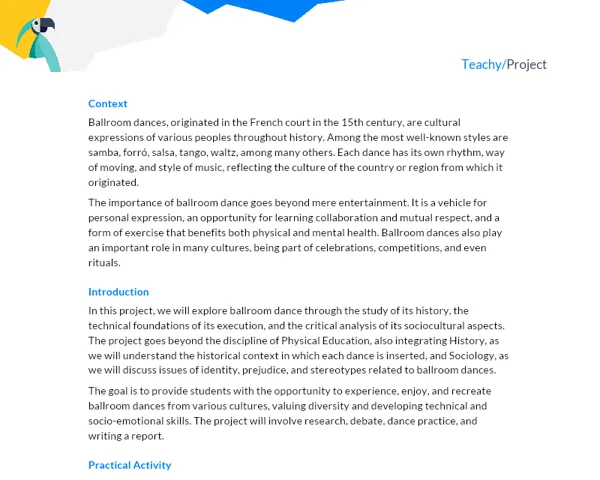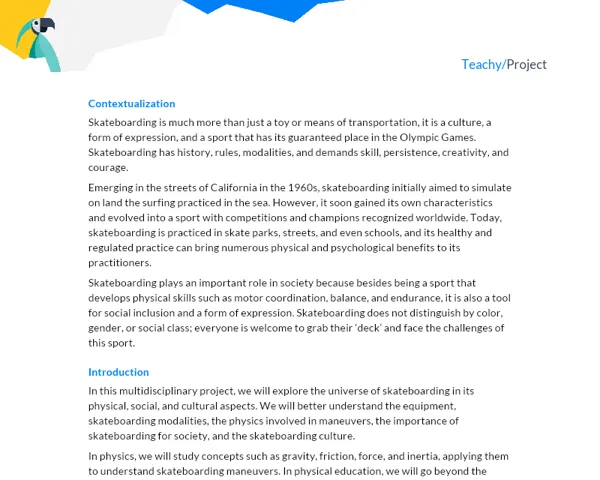Contextualization
Basketball, also known as "basketball", is a popular sport loved by millions of people worldwide. Invented by Canadian James Naismith in the late 19th century with the intention of creating a physical activity that could be practiced indoors during the winter, the sport is now played on all continents and has famous professional leagues, such as the NBA in the United States and the Brazilian Basketball Championship.
Introduction to Basketball
In basketball, the goal is to score as many points as possible by throwing a ball into a basket elevated from the ground. There are always two competing teams, and the number of points a team can score per shot varies according to the distance the player is from the basket when making the shot. In addition, players must dribble or pass the ball while moving on the court, not being allowed to walk with the ball without dribbling.
Basketball Rules and Scoring
Understanding the rules and scoring system is essential to understand the game, as they govern everything from how a player can move with the ball to how many points a shot is worth. Furthermore, basketball rules are adjusted to fit different levels of play, such as elementary school, high school, and professional, as well as to accommodate different playing styles in different countries.
The Importance of Basketball
Basketball is more than just a game. It teaches valuable skills such as teamwork, communication, time management, and problem-solving. The sport also helps develop physical skills such as motor coordination, endurance, and strength. Additionally, basketball has a significant cultural impact, particularly in the United States, where NBA players are often seen as heroes and role models.
Practical Activity
Activity Title: "Basketball Game: Learning through Practice"
Project Objective
The objective of this work is to organize a basketball tournament at school where groups will not only play but also organize the event, plan training sessions and strategies, as well as conduct an in-depth study on the rules and history of basketball.
Detailed Project Description
Students will be divided into groups of 3 to 5 members. Each team will be responsible for developing a training plan, thoroughly understanding the rules of basketball, and studying its history and global cultural impact. Additionally, together, the groups will be responsible for organizing the tournament, including scheduling games, defining rules, and managing scoring.
To meet the requirement of involving at least two subjects, this project will involve Physical Education, through sports practice and knowledge of basketball rules, and History, through the analysis of its development and cultural impact.
This project requires a workload of more than twelve hours per student, divided into planning and training sessions, studying the rules and history of basketball, and the actual tournament execution.
Required Materials
- Basketball balls
- Basketball court
- Vests to identify teams
- Stopwatch
- Whistle
- Material for notes (papers, pens, etc.)
- Internet or books for research
Step by Step
- Divide the class into groups of 3 to 5 students.
- Each group should research the rules and history of basketball, including NBA teams, the Brazilian basketball championship, and the game scoring. The use of resources suggested in the project introduction stage is recommended.
- The groups should plan and conduct basketball training sessions, improving their skills and familiarizing themselves with the rules of the sport.
- Students, together, should plan the tournament, including defining rules and scheduling games.
- Conduct the tournament, where active participation, sportsmanship, and respect for the rules will be evaluated.
- At the end of the tournament, each group should write a report detailing their experience in all stages of the project.
Project Deliverables
Students must submit a final written report containing:
- Introduction: Contextualization of basketball, its relevance and real-world application, as well as the objective of this project.
- Development: Presentation of the theory studied about basketball, detailed explanation of the training planning and tournament execution, and presentation of the results obtained.
- Conclusions: Reflective analysis on teamwork, acquired learning, and skills developed during the project.
- Bibliography: Citation of sources consulted during research and the project.
This report should be a detailed reflection of the work done, the theoretical and practical learning acquired, as well as the socio-emotional skills developed. It should demonstrate not only the knowledge acquired about basketball but also the development of time management, communication, problem-solving, creative thinking, and proactivity skills.



